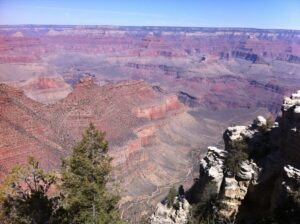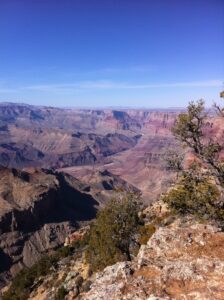 You stare out at the most enormous vista you’ve ever seen. You’re surrounded by a silence that’s so calm, yet so all-consuming that you let out a nervous giggle just to make sure you’re still part of it. You stretch your arms out as far as they can go to either side to see if you can give the view a vast bear hug, but the panorama escapes and trickles through your fingers towards the horizon. You feel something wet hit your cheek. Before you’ve even realized it, the Grand Canyon has reduced you to tears with its sheer, untouched beauty.
You stare out at the most enormous vista you’ve ever seen. You’re surrounded by a silence that’s so calm, yet so all-consuming that you let out a nervous giggle just to make sure you’re still part of it. You stretch your arms out as far as they can go to either side to see if you can give the view a vast bear hug, but the panorama escapes and trickles through your fingers towards the horizon. You feel something wet hit your cheek. Before you’ve even realized it, the Grand Canyon has reduced you to tears with its sheer, untouched beauty.
If you think this is some part of the great outdoors that’s only for athletes, let me concur: I thought the same thing. I’m not a hiker or often much of a fresh-air fanatic, and yet my trip to the Grand Canyon will remain one of the standout experiences of my life — it really will appeal to everyone.
Arizona’s Grand Canyon is inside one of America’s first national parks. The Canyon itself runs 277 miles long and ranges from 4 – 18 miles wide. It was carved into the Colorado Plateau by the flow of the Colorado River. Some parts of the Canyon are newer than others, but it’s generally thought that the Colorado River started carving its course through the Canyon 17 million years ago.
Because the Canyon is so vast and vibrant, a trip there can really be as extensive as you make it. If you apply for the correct permits before you go, you can even go camping inside the Canyon. (Contact the National Parks Service for permits.) But presuming you’re not up for doing this explorer-style, there are two things you should do to get a grand Grand Canyon experience.
The first is to see the Canyon by air. Helicopter tours take off from Tusayan, a town a few miles away from the Canyon rim, and you can pick a flight that suits your tastes, depending on how much of the Canyon you’d like to take in. Rides with Papillon Helicopter Tours run from $150 to $220 for 30 to 45 minutes. It’s expensive, but the rush of seeing miles of expansive Canyon beauty from the air is a priceless memory. (If you get motion sickness or are not great with heights, you should still try the 30-minute ride, because the time passes in a flash.)
The other must-do at the Canyon is to explore it by foot. When you enter the Canyon Park, you’ll be given an easy-to-use map that details the many hiking trails in the Canyon. These include the flat, wheelchair-accessible Rim Trail that sticks to the lip of the Canyon and has fantastic views. This trail also hugs the route of the free bus system that runs through the park, so if you wander a little too far, you can always hop on one of these buses to get back to your hotel. The other trails delve down into the Canyon – they are still entirely doable, but you’ll work up more of a sweat here.
enter the Canyon Park, you’ll be given an easy-to-use map that details the many hiking trails in the Canyon. These include the flat, wheelchair-accessible Rim Trail that sticks to the lip of the Canyon and has fantastic views. This trail also hugs the route of the free bus system that runs through the park, so if you wander a little too far, you can always hop on one of these buses to get back to your hotel. The other trails delve down into the Canyon – they are still entirely doable, but you’ll work up more of a sweat here.
While taking in these beautiful views, make sure you hike smart — the Canyon is likely to be at a higher altitude than where you’ve come from (it’s roughly 8,000 feet above sea level), so drink extra water, and don’t push yourself if you feel the altitude — an afternoon nap never hurts. Also, while you’re sure to pass other walkers along your trails, never go hiking alone. There’s no way to ensure you’ll be completely safe by yourself, and it costs $6,000 to be heli-evaced out of the park!
 Once you’re done exploring the Canyon, finish your day by taking in a picture-perfect sunset. The time of sunset will be noted each day at most of the rest stops or restaurants. Get there about 90 minutes before the noted time to watch the sky’s colors change. The Park recommends Hopi Point for sunset-viewing, but if you walk a little further west along the rim, you’ll get to Mojave Point that has the same perfect view but nowhere near as many of the people.
Once you’re done exploring the Canyon, finish your day by taking in a picture-perfect sunset. The time of sunset will be noted each day at most of the rest stops or restaurants. Get there about 90 minutes before the noted time to watch the sky’s colors change. The Park recommends Hopi Point for sunset-viewing, but if you walk a little further west along the rim, you’ll get to Mojave Point that has the same perfect view but nowhere near as many of the people.
If you have the energy, get up and find a new trail the next day! You’ll never see the same thing twice in this dynamic and truly exquisite natural wonder of the world.


